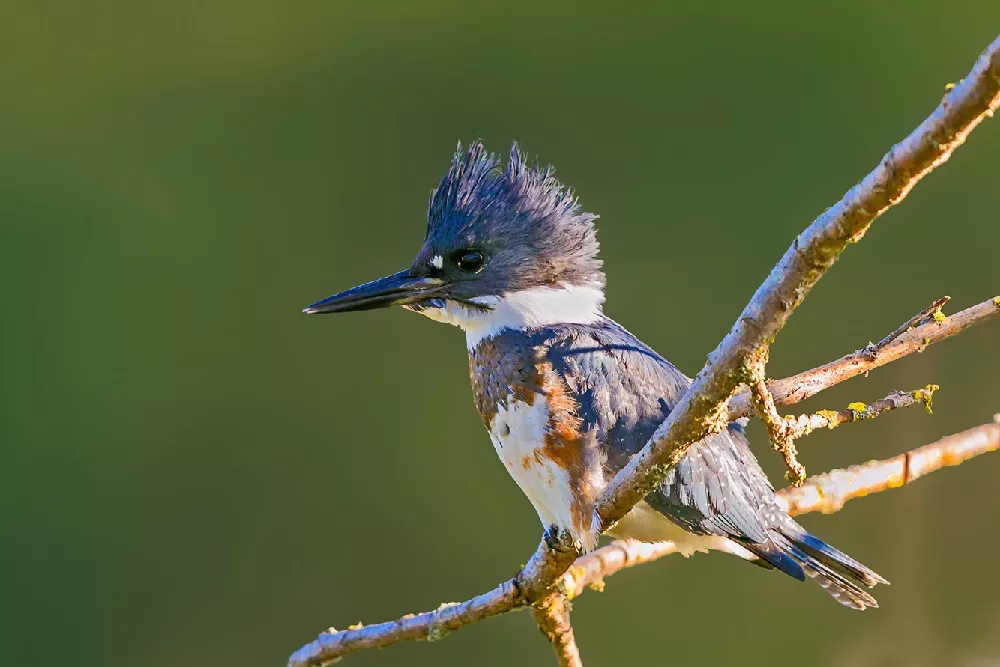The Belted Kingfisher (Megaceryle alcyon) is not only admired for its impressive fishing skills and striking appearance but also for its distinctive vocalizations. These avian predators are known for their unique calls that resonate through their habitats. In this article, we explore the captivating sounds of the Belted Kingfisher, unraveling their vocal repertoire and the significance of their calls.
Rattling Call: A Signature Sound
The most iconic vocalization of the Belted Kingfisher is its rattling call, which is often heard near bodies of water. The call is a loud and unmistakable series of rapid, machine-like rattles, reminiscent of a harsh, metallic sound. It carries over long distances and is used for various purposes, including communication, territorial defense, and courtship displays.
Territorial and Advertising Calls:
Male Belted Kingfishers use their rattling calls to establish and defend their territories. They may engage in high-flying displays, accompanied by their vocalizations, as they patrol and assert their ownership over their preferred hunting grounds. The calls serve as auditory markers, warning off potential intruders and declaring their presence to conspecifics.
Courtship Calls and Vocal Displays:
During courtship rituals, both male and female Belted Kingfishers produce distinct vocalizations. The male initiates courtship by performing a series of elaborate aerial displays, accompanied by vocalizations. These displays can include soaring flights, looping maneuvers, and rapid wingbeats, creating a visual spectacle. The calls emitted during courtship are softer and more melodious compared to their rattling calls. They consist of a sequence of repetitive, descending notes or a rolling “chick-a-dee-dee-dee-dee” sound. These calls serve as a means of communication and bonding between potential mates.
Alarm Calls:
Belted Kingfishers possess a repertoire of alarm calls to warn of potential threats or disturbances in their surroundings. When startled or detecting a predator, they emit a rapid series of high-pitched, staccato calls that serve as a signal to other individuals in the area. These alarm calls are often accompanied by an aggressive flight display, where the kingfisher swoops and dives to intimidate the perceived threat.
Variations and Individuality:
While the rattling call is the most recognizable vocalization of Belted Kingfishers, it is worth noting that there can be variations in their calls, both in terms of rhythm and pitch. Individual birds may exhibit slight differences in their vocalizations, creating a unique identity for each bird. These variations can be influenced by factors such as age, gender, and regional dialects within their populations.
Ecological Significance:
The vocalizations of Belted Kingfishers serve vital ecological functions within their habitats. Their rattling calls play a crucial role in territorial defense, preventing intrusions from conspecifics and maintaining exclusive hunting territories. Alarm calls help warn other individuals of potential threats, facilitating collective vigilance and predator avoidance. Courtship calls strengthen pair bonding and communication during the breeding season, ensuring successful reproduction and continuation of the species.
Conclusion:
The Belted Kingfisher’s vocalizations add an enchanting dimension to its already captivating presence. From the signature rattling call that resonates through waterways to the melodious courtship calls and alarm signals, these avian predators demonstrate a rich vocal repertoire. By appreciating and understanding the significance of their vocalizations, we gain a deeper appreciation for the complex communication systems and behaviors of these remarkable birds, fostering a greater connection with the symphony of nature that surrounds us.


 Facebook
Facebook  Instagram
Instagram  Youtube
Youtube 